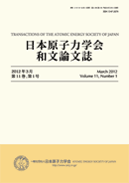
- Issue 4 Pages 169-
- Issue 3 Pages 107-
- Issue 2 Pages 63-
- Issue 1 Pages 1-
- |<
- <
- 1
- >
- >|
-
Masaki ANDOH, Norihiro MATSUDA, Kimiaki SAITO2017 Volume 16 Issue 2 Pages 63-80
Published: 2017
Released on J-STAGE: May 15, 2017
Advance online publication: February 28, 2017JOURNAL FREE ACCESSIn order to determine the contribution of radioactive cesium due to the Fukushima Daiichi nuclear power plant accident to the ambient dose equivalent rates measured by car-borne surveys, natural background radiation was evaluated for eastern Japan as municipality-averaged values. The window count method for the distinction between natural and artificial radioactive nuclides was applied to car-borne surveys using KURAMA–II. The distribution of the evaluated natural background radiation reflected geological features, and it was found that the radiation measured along paved roads reflected the distribution of terrestrial gamma rays. The contribution of the radioactive cesium as of 2014 for the municipalities designated as the Intensive Contamination Survey Area was beyond the uncertainty of the natural background radiation. That for the other municipalities, however, was found to be almost negligible.
View full abstractDownload PDF (2099K)
-
Juntaro SHIMIZU, Shunsuke OHTSUBO2017 Volume 16 Issue 2 Pages 81-88
Published: 2017
Released on J-STAGE: May 15, 2017
Advance online publication: January 31, 2017JOURNAL FREE ACCESSEvaluation of the atmospheric-pressure change (APC) in a tornado is necessary to assess the integrity of nuclear-related facilities. The Rankine model has been most frequently used to theoretically calculate the APC in a tornado. The result, however, is considered to be overly conservative because the Rankine model wind speed at the ground is larger than that in reality. On the other hand, the wind speed of the Fujita model is closer to that of actual tornadoes but is expressed by more complicated algebraic equations than that in the Rankine model. Also, because it is impossible to analytically derive the APC equation using the Fujita model, numerical computation is required. A previous study employed the finite element method (FEM) for such a purpose. However, a general-purpose FEM code often requires complicated input parameters. In order to conduct parametric studies to evaluate the integrity of facilities in various cases of tornadoes, the finite-difference method code “TORPEC”, which is specialized to analyze the APC, was developed as a convenient design tool. TORPEC is based on Poisson’s equation derived from the Navier-Stokes equation. It also runs on widely available technical calculation software such as Microsoft® Excel VBA or MATLAB®. Taking advantage of such convenience, various calculations have been conducted to reveal the characteristics of APC as functions of the maximum tangential wind speed, axial position and tornado radius. TORPEC is used as a benchmark in the existing paper. The case study results obtained by TORPEC show a constant ratio of the pressure drop of the Fujita model against the Rankine model. This factor can be used to derive the Fujita model result from the Rankine model result without FEM analysis.
View full abstractDownload PDF (2054K) -
Hitoshi MUTA, Ken MURAMATSU, Yuki KAMEKO, Hiromichi MIURA, Katsunori O ...2017 Volume 16 Issue 2 Pages 89-99
Published: 2017
Released on J-STAGE: May 15, 2017
Advance online publication: February 14, 2017JOURNAL FREE ACCESSAfter the severe accident at the Fukushima-Daiichi nuclear power station, the regulation of nuclear plant safety in Japan was upgraded, and continuous effort to enhance risk management in the medium and long term is required. Seismic risk is important in Japan, and one of the major issues of current probabilistic risk assessment (PRA) methodology is the enhancement of seismic PRA including the evaluation of initiating events induced by simultaneous multiple failures of components and of subsequent accident sequences. The Nuclear Regulation Authority (NRA) addressed the issue as “…multiple-failure-initiating events should be considered.” In addition, the standard for the procedure of seismic PRA for nuclear power plants in 2015 identifies this issue in the same manner. This study proposes an enhanced seismic PRA methodology considering multiple-failure-initiating events that is expected to contribute to improving the safety of nuclear power plants. This study also discusses the issues that need more research for their resolution.
View full abstractDownload PDF (1402K) -
Yasuhiro ISHIJIMA, Fumiyoshi UENO, Hitoshi ABE2017 Volume 16 Issue 2 Pages 100-106
Published: 2017
Released on J-STAGE: May 15, 2017
Advance online publication: March 07, 2017JOURNAL FREE ACCESSZirconium (Zr) has been used as a structural material at the spent nuclear fuel reprocessing plant in Japan because of its excellent corrosion resistance against nitric acid solution. However, radiolytic hydrogen is known to be generated in spent nuclear fuel solution. Zr is known to be highly susceptible to hydrogen embrittlement. Therefore, evaluating the radiolytic hydrogen absorption behavior of Zr in nitric acid solution (HNO3) is essential. In this study, immersion tests were conducted on Zr in nitric acid solutions under γ-ray irradiation to evaluate its radiolytic hydrogen absorption behavior. Results showed that the hydrogen concentration on Zr increased in both 1–3 mol/L HNO3 and pure water upon irradiation of 5 and 7 kGy/h after immersion. The amount of hydrogen absorption on Zr under γ-ray irradiation had a direct correlation with the amount of radiolytic hydrogen generated in HNO3. The results of glow discharge optical emission spectrometry, thermal desorption spectroscopy, and X-ray diffraction show that the absorbed radiolytic hydrogen generated a hydride on the surface of Zr.
View full abstractDownload PDF (1204K)
- |<
- <
- 1
- >
- >|